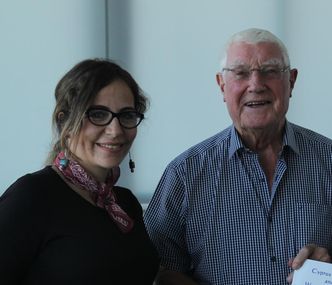
FACULTY OF COMMUNICATION
News
GAÜ'DEN

Asst. Prof. Dr. Ümmü Altan Bayraktar, lecturer in the Girne American University, Faculty of Communication, Department of Journalism and Broadcasting, interviewed Mr Richard Chamberlain, the g
U.A.B.: How and when did you fist have knowledge of Cyprus?
R.C.: When I joined the army in 1954 and was sent to Cyprus.
U.A.B.: How and where did you fly to in Cyprus?
R.C.: The Nicosia Airport after landing and re-fuelling in Malta Valletta. I arrived to Cyprus on May, 28, 1954. We landed at the Airport of Nicosia – it was a type of airplane with an old propeller, not the jets as they are now. And we had to land during the flight to refill the motor because the airplanes just couldn’t carry enough fuel at that time. We, a lot of soldiers, all were on the plane together and we were all told to take our boots off because we had these big combat boots and we had to remove them because the people who owned the planes didn’t want all their carpets to be ruined by our boots. So… we were sitting there on the plane without shoes. (laughs) Like that!
U.A.B.: Where were you stationed in Cyprus?
R.C.: We were stationed at 4 Mile Point (Ayios Nicholias) just outside Famagusta.
U.A.B.: What was your duty?
R.C.: Special Wireless Operator. Listening to morse code messages sent by the Russians. When we got to Nicosia the army lorries were waiting there for us to take us to our camp and I was assigned to go to Famagusta where I was a wireless operator in the army and there was what they call listening post in Famagusta and that was a big wireless station and I used to listen to the enemy of those times, i.e. Soviet and the Eastern Block, and I used to listen to their morse code and tried to get information, to know what is happening on the other side. We went to Famagusta. We were very tense in those days… I was showed the wireless room. A great big room with about 50 radios there. We all started listening to morse code which was being sent from other countries. Apart from that, we had quite a bit of time off and we spent a lot of time going down to Famagusta. There was no transport in those days so we used to stand on the side of the road. It was called 4 Miles Point and it was 4 miles outside Famagusta and we used to stand on the side of this road and. The lorries used to stop and we all used to climb on the back of a lorry and they used to take us down to Famagusta. That,s how we reached lovely Famagusta beach and it was so different… I mean, anybody who goes to Famagusta now can see how all the roads and hotels and even part of Famagusta, which we know, is shut off. I believe it is known as Maraş or Varosha. Anyway, part of it was open and we could go anywhere. Without any fear or any problems. We spent a lot of time on the beach and there was an army house. We used drink beer there and have a rest. It was really lıke being in paradise after the life in England.
U.A.B.: How and why did you get interested in photography?
R.C.: Well I had a brother in England who was 7 years older than me and because when I was about 16 he was about 23. He was very interested in photography and he was a very capable man with his hands and funny enough he made me out of a Colman’s Mustard tin a little camera and I started take. I took it to school and than I started taken photographs the other boys in the class and I went out and develop the film and took to print and took them back. I used to sell them 2.5 pence in English money.
U.A.B.: What camera did you use?
R.C.: I bought this French manufactured camera. It was all metal aluminum camera good for the army because if it gets knocked a bit – it is still not damaged. And I still have this camera with me now.
I’ll be able to show it later on if anybody is interested. I took the camera in and straight away loaded up with film. Films were not digital those days. I took the camera almost every day and almost everyday I could see something different. Like camels walking down the street which I’ve got photographs of. Or Kyrenia Horbour, where people used to swim and sail. We’ve got photographs of things as just they were then and things that evoluted quite a lot now. I’ve done another book showing how things evoluted 60 years later.
Luckily, they had a dark room down in Famagusta and they allowed any soldiers to go down there and develop their films afterwards. I used to enlarge the photos and see what things came out. So I ended up with quite a lot of old black and white photos as well as the negatives.
U.A.B.: What did you do with the photos when you left the army?
R.C.: When I came back after the army I had this big collections of negatives, black and white photographs. And the thing was that… if one can look back 1956 or 1955 there was not a lot of interest. I know the EOKA terrorist were going on there was a lot. In the outside world, especially in England where I lived, there was not a lot of interest to these photos. So I put all the negatives and prints away in the cupboard. I’ve sort of virtually forgot about them until such times as about 15 years ago. There was a lot more information circulating all around about the line which goes thorough Cyprus dividing the Turks and the Greeks. So, I got all the negatives and prints out and started producing this book which is being quite popular actually.
http://gau.edu.tr/images/uploads/richard_chamberlain1.jpg" alt="" />
U.A.B.: In 1954, on the 6th of June, it was Queen`s Birthday. Have you taken the last photograph of the Queen’s Birthday Parade in Cyprus?
R.C.: I arrived on the 28th of May. By that time the soldiers have already been practicing quite a lot of march, up and down the road of the parade. Well, they put me in the parade and they said that I wasn’t good enough to march. I was quite pleased about that because they also gave me the day off. That was really good, obviously, because I was able to go down to Famagusta and take all the photographs. It was also amazing because that was in 1954, and than the EOKA terrorist broke out and the British Army authorities decided not to have another Queen`s Birthday Parade in 1955 because they didn’t want the troops marching up and down and being in any risk. So I think I might be wrong but I’ve taken the last photographs of the Queen`s Birthday Parade in Cyprus.
U.A.B.: How long did you stay in Cyprus?
R.C.: I’ve stayed here for a year. I have got a twin brother and we were both in the army and in Cyprus for the year. Aferwards, they asked us whether we would like to sign on for a longer period. But I had already signed for an apprenticeship in one printed industry. And they released you on condition that you went back after 2 years. Otherwise they would have cancelled my apprenticeship. Although I enjoyed being in Cyprus, I’ve got chance to go home. I took it and returned to the UK.
U.A.B.: Did you travel elsewhere in the island?
R.C.: Obviously, we used to get holiday or leave in the army. In the army they used to give us time off. My brother was a driver and we used to go down to Famagusta and hire a car. About four or five of us used to get together and go around the island in a car. We took an army blanket with us and slept out on the ground. It wasn’t obviously cold – the weather was lovely, evenings were amazing, nights were warm – you just lay down and go to sleep. And in the morning we got up and made a cup of tea…. We then went to Trodos – to the region which is considered “South” now. We have been to Limassol, Larnaca, and Paphos. Many photographs based in Famagusta were also taking pictures in the South of the island.
U.A. B.: How did you get on with the Cypriot People?
R.C.: All the soldiers got on with Cypriot people. Cypriot people welcomed us. I remember one occasion…. There was a wedding in Famagusta. My brother and I, and some other men, were walking down the street and we all got invited to this wedding, were given drinks and danced. You know, such sort of things will never happen in England. People here were so friendly. A couple of times I needed lifts back to the camp. Once a man on the motorbike stopped and he said: “I’ll give you a lift but I am going to my mother first because it is her birthday”. He asked: “Don`t you mind if I go there first?” and I said that we could go there, surely. So we drove down to his mother`s place and we were soon enjoy’ng food and drinks altogether! It was so friendly, heart warming, and lovely.
http://gau.edu.tr/images/uploads/richard_chamberlain1.jpg" alt="" height="300" />
U.A.B.: When did you decide to move to Cyprus to live?
R.C.: I’ve been back about 15 times since I was in the army up until recently. Wew came back mainly to the North and my wife and I were married. She liked Cyprus but didn’t really come out here. I wanted to live here but she was not really willing to stay on the island for a long time. Obviously, I couldn’t come on my own. But last year my wife died and my daughter has been living in Çatalköy for 3 years. So when my wife died I sold up my house and moved over here with my dog. After a while I met this lovely lady Wilma and we got engaged. We live together in Ozankoy now and we wait for the court`s permission to get married.
U.A.B: What would you like to say about your books?
R.C.: I came to Cyprus in 1954-55 to serve in the royal signals of the British Army. When I came, I was interested in photography. So I brought an old camera with me and started to photo almost everything I could see because it was so different for me! I just found everything interesting, being of different life style. Climate and people seemed unusual. And, obviously, in England we didn’t see anything like camels, sheep or goats walking down the the street. I made photos of local people, buildings, beaches and thus have built up a collection of about 300 black and white photos. I’ve produced the book with all these photos in. I’ve sold and given away about thousand of books now – many people got interested in how things were at those times. The names of my books: “Cyprus Scenes and Way of Life in 1954/55” and “Cyprus Scenes and Way of Life in 1954/55 and Sixty Years Later in 2014”.
By Asst. Prof. Dr. Ümmü ALTAN BAYRAKTAR
GAU Communication Faculty
Journalism and Broadcasting Department

